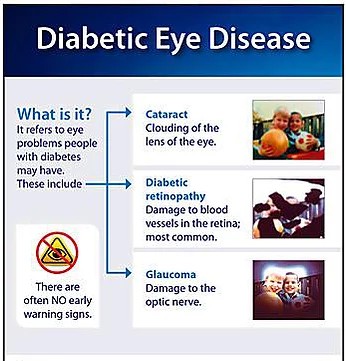
DIABETIC EYE DISEASE
What is diabetic eye disease?
Everyone with diabetes can develop diabetic eye disease but some groups are affected more than others.
Diabetic eye disease includes;
- Diabetic retinopathy: Damage to the blood vessels in the retina.
- Cataract: Clouding of the lens of the eye.
- Glaucoma: Increase in fluid pressure inside the eye that leads to optic nerve damage and loss of vision.

Who is at risk?
People with diabetes are at a greater risk of getting diabetic eye disease. The longer a person has diabetes, the greater their risk of developing diabetic eye disease.
Cataract also develops at an earlier age in people with diabetes. And a person with diabetes is nearly twice as likely to get glaucoma as other adults.
Fortunately, early detection, timely treatment and appropriate follow-up care can help reduce severe vision loss from diabetes by 95%.
How is diabetic eye disease diagnosed?
Regular eye exams, including a comprehensive dilated eye exam. This is because diabetic eye disease has no warning signs. A comprehensive dilated eye exam is the only way to find the disease early so it can be treated before it causes vision loss or blindness. Early detection is extremely important, so a treatment plan can be started.
NOTE; There are often no warning signs; people with diabetes MUST have an eye exam at least once a year to keep their health on T-R-A-C-K to prevent vision loss.
